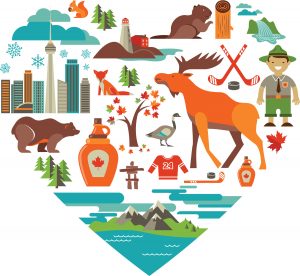Online Content
150 Little Known Canadian Facts #1
February, 2017
In honour of 2017 being Canada’s 150th birthday—it doesn’t look a day over 100—we at T8N will be giving our readers 150 little known facts about this great country. Now, 150 facts all in one sitting is a bit much, so from now until the end of July each issue of the newsletter will have “timbit-sized” chunks to illuminate, astonish and amuse you.

- Canada’s official motto is “A Mari usque ad Mare” which is Latin for “From Sea to Sea.” The phrase was taken from Psalm’s 72:8 during the Confederation as an inspirational statement, even though Canada at that time had only one coastline—the Atlantic. It wasn’t until British Columbia joined in 1871 did the statement ring true. It was first officially used in 1906 when it was engraved on the Legislative Assembly’s mace of the new province of Saskatchewan. Today, at the suggestion of the three territories, Canadians are using “From Sea to Sea to Sea” to include the Arctic coast, though it’s not official.
2. In 1857, a professor at McGill University invented the green ink used on American greenback money. Thomas S. Hunt was a chemist with the Canadian Geological Survey, and he suggested that the American banknote contain chromium trioxide (Cr2O3). It’s this chemical that makes counterfeiting American money tricky.
3. Narcisse Snake Dens Conservation Area, which is 130 kms north of Winnipeg, is the garter snake capital of the world. Every May, red-sided garter snakes—plus four other species—emerge from their winter dens and slither about under the warm sun. Each den or hibernaculum can contain approximately 10,000 garter snakes.
4. The creation of Alberta and Saskatchewan weren’t the only option the Canadian government was considering when dividing up the prairies. One plan called for the creation of one large prairie province called “Buffalo” with Regina as its capital. Another plan called for four prairie provinces: Alberta, Saskatchewan, Athabasca and Assiniboia.
5. While Canada has two official languages (English and French), it’s also home to over 60 indigenous languages that aren’t spoken anywhere else in the world. Of these 60-plus languages, most are in danger of being lost. Stats Canada estimates that only Cree, Ojibwa and Inuktitut have enough speakers for the languages to survive without outside aid.
6. Newfoundland was the final province to join confederation when it became a province in 1949. Before this, Newfoundland was considered a British dominion, but functioned as in independent nation. It was responsible for maintaining its own currency and military, and it even had its own flag and national anthem.











